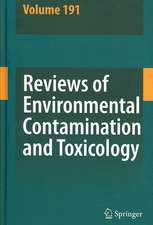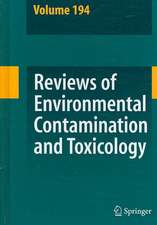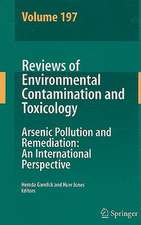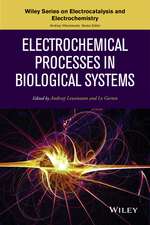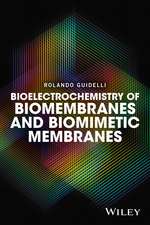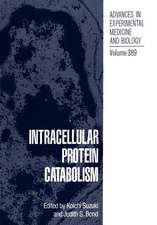Molecular Life Sciences: An Encyclopedic Reference
Editat de Robert D. Wells, Judith S. Bond, Judith Klinman, Bettie Sue Siler Masters, Ellis Bell, Laurie S. Kagunien Limba Engleză Hardback – 12 ian 2018
Preț: 4738.22 lei
Preț vechi: 5778.32 lei
-18% Nou
Puncte Express: 7107
Preț estimativ în valută:
906.65€ • 987.93$ • 763.99£
906.65€ • 987.93$ • 763.99£
Carte disponibilă
Livrare economică 02-16 aprilie
Preluare comenzi: 021 569.72.76
Specificații
ISBN-13: 9781461415299
ISBN-10: 1461415292
Pagini: 10000
Ilustrații: XV, 1247 p. 456 illus., 307 illus. in color. In 2 volumes, not available separately.
Dimensiuni: 178 x 254 mm
Greutate: 3.03 kg
Ediția:1st ed. 2018
Editura: Springer
Colecția Springer
Locul publicării:New York, NY, United States
ISBN-10: 1461415292
Pagini: 10000
Ilustrații: XV, 1247 p. 456 illus., 307 illus. in color. In 2 volumes, not available separately.
Dimensiuni: 178 x 254 mm
Greutate: 3.03 kg
Ediția:1st ed. 2018
Editura: Springer
Colecția Springer
Locul publicării:New York, NY, United States
Public țintă
ResearchDescriere
Molecular Life Sciences: An Encyclopedic Reference is a partnership between the American Society for Biochemistry and Molecular Biology and Springer. A major encyclopedic work, it will consist of multiple volumes focusing on understanding biological phenomena at the level of molecules and their interactions that govern life processes. Articles will include those with a focus on genes and genomes, and will contain areas such as DNA Replication, Repair and Recombination, Genes: Structure and Regulation, RNA Structure, Metabolism and Catalysis, Protein Synthesis, Post-translational Modification and Degradation, Transcription, Chromatin and Epigenetics, RNA Mediated Regulation and Non-Coding RNA, Genomics, Proteomics, Bioinformatics and Computational Approaches to Structure and Function. Also included will be articles on Protein Structure and Function featuring secondary, tertiary and quaternary structure, Protein Folding, Protein Dynamics, Enzyme Catalysis and Regulation, Metabolism and Bioenergetics, Ligand Binding and Protein Interactions, Mechanisms of Signal Transduction, Signal Transduction and Immunity, Molecular Basis of Cell and Developmental Biology, and Signal Transduction and Systems Biology. The molecular aspects of cell structure and function will be included with articles on Glycobiology and Extracellular Matrices, Lipids and Lipoproteins, Membrane Transport, Structure, Function and Biogenesis, and Metabolomics and Systems Biology; also included will be Unifying Concepts and Theory from Biology, Chemistry and Physics that are foundational for understanding the molecular life sciences together with articles on Teaching Perspectives and Assessment Tools.
Each volume will include an overview describing the inter-relatedness of the themes of the section to facets of the molecular life sciences. Detailed overviews will be included along with a number of mini-reviews and shorter discussions of details and definitions, including appropriate experimental approaches.
Each volume will include an overview describing the inter-relatedness of the themes of the section to facets of the molecular life sciences. Detailed overviews will be included along with a number of mini-reviews and shorter discussions of details and definitions, including appropriate experimental approaches.
Cuprins
Allostery and Quaternary Structure.- Analysis of Damaged DNA.- Artificial Chromosomes.- Artificial Endonucleases for Genome Editing.- Bacterial DNA Replicases.- Bacteriophage and Viral Cloning Vectors.- Base Intercalation.- Bioactivation of Carcinogens.- Bioinorganic Chemistry.- Blue/White Selection.- Characteristics of Enzymes and Cloning Vectors Used to Create Recombinant DNA.- Chemical Biology of DNA Replication.- Chemical Denaturation.- Chemical Reaction Kinetics: Mathematical Underpinnings.- Chromatin Remodeling during Homologous Recombination Repair in Saccharomyces Cerevisiae.- Cis-Regulation of Eukaryotic Transcription.- Classic Approaches to sequence determination.- Classical and Alternative End Joining.- Cloning Vector Compatibility.- Computational methods in epigenetic research.- Conjugative Transfer Systems and Classifying Plasmid Genomes.- Conservative Site-specific Recombination.- Control of Initiation in E.coli.- Co-Transcriptional mRNA Processing in Eukaryotes.- Crosslinking.- Cycling of the Lagging Strand Replicase During Okazaki Fragment Synthesis.- Depurination.- Differential Equations and Chemical Master Equation Models for Gene Regulatory Networks.- Direct Enzymatic Reversal of DNA Damage.- Division of Labor.- DNA Damage as a Therapeutic Strategy.- DNA Damage by Endogenous Chemicals.- DNA Methylation and Cancer.- DNA Polymerase III Structure.- DNA Repair.- DNA Repair Polymerases.- DNA Replication.- DNA Topology and Topoisomerases.- DnaA, DnaB, DnaC.- DnaX Complex Composition and Assembly Within Cells.- Double-strand Break Repair.- Effects of adducts on Tm.- Equilibria and Bifurcations in the Molecular Biosciences.- Eukaryotic DNA Replicases.- Evolution of Gene Regulatory Networks.- Evolution of Plant Genomes.- Exocyclic Adducts.- Experimental Assessment of Secondary Structure by Circular Dichroism.- Exploring Nuclear Lamin–Chromatin Interactions and Their Signalling Cascades.- Expression Assessment.- Fatty Acid Metabolism.- Forces Maintaining the Stability of Tertiary Structure.- Frequency of DNA Damage.- Gene Regulation.- Genes and Genomes: Structure.- Genomic Imprinting.- Genomic Imprinting in Mammals: Memories of Generations Past.- Genomic Sequence and Structural Diversity in Plants.- Genomic Signature Analysis to Predict Plasmid Host Range.- Golgi Apparatus.- Gyrase and Topoisomerase IV as Targets for Antibacterial Drugs.- HDAC Inhibitors Entinostat and Suberoylanilide Hydroxamic Acid (SAHA): The Ray of Hope for Cancer Therapy.- Helicase and Primase Interactions with Replisome Components and Accessory Factors.- Helicase Mechanism of Action.- Hereditary Breast and Ovarian Cancer and Poly(ADP-ribose) Polymerase Inhibition.- Homologous Recombination in Lesion Bypass.- Hydrolytic, Deamination, and Rearrangement Reactions of DNA Adducts.- Immunology and the Immune Response.- In Silico Approaches Towards Safe Targetting of Class I Histone Deacetylases.- Inflammation and Host Response to Infection.- Innate and Regulatory B cells.- Innate Immunity.- Ion Channels and Transporters.- Kinetics of DNA Damage.- Large, Theta-replicating Plasmids.- Long-Term Genetic Silencing at Centromere and Telomeres.- Mammalian Sugar Transporters.- Many Bacteria Use a Special Mutagenic Pol III in Place of Pol V.- Mass Spectrometry Approaches.- Mathematical Modelling of Plasmid Dynamics.- Mathematical Models in the Sciences.- Mathematics of Fitting Scientific Data.- Mechanism of Initiation Complex Formation.- Mechanism of PCNA loading by RFC.- Mechanisms of DNA Recombination.- Meiotic Recombination.- Metamobilomics – The Plasmid Metagenome of Natural Environments.- Methods for Plant Genome Annotation.- Mismatch Repair.- Mitochondrial Genomes.- Mitochondrial Genomes in Alveolates.- Mitochondrial Genomes in Amoebozoa.- Mitochondrial Genomes in Fungi.- Mitochondrial Genomes in Invertebrate Animals.- Mitochondrial Genomes in Land Plants.- Mitochondrial Genomes in Unicellular Relatives of Animals.- Mitochondrial Genomes in Vertebrate Animals.- Mitochondrial Genomes of Chromists (Stramenopiles, Haptophytes and Cryptophytes).- Mitochondrial Genomes of Excavata.- Mitochondrial Genomes of Green, Red and Glaucophyte Algae.- Mobile DNA: Mechanisms, Utility, and Consequences.- Modelling Plasmid Regulatory Systems.- Modes of Base Pairing.- mRNA localization and localized translation.- Naming and Annotation of plasmids.- Natural Products that Damage DNA.- NMR Approaches to Determine Protein Structure.- NMR Basis For Biomolecular Structure (Theory).- Nucleotide Excision Repair.- Obtaining Crystals.- Oxidative Damage.- Pattern Recognition Receptors: Evolution, Redundancy, and Cross Talk.- PCNA Structure and Interactions with Partner Proteins.- Peptide Pheromones and their Protein Receptors: Cellular Signaling in Gram-positive Bacteria.- Phagocytosis.- Plant Genome Sequencing Methods.- Plant Genomes: From Sequence to Function Across Evolutionary Time.- Plant Transposable Elements: Beyond Insertions and Interruptions.- Plasmid Cloning Vectors.- Plasmid Genomes, Introduction to.- Plasmid Incompatibility.- Plasmids as Secondary Chromosomes.- Polyglutamine Folding Diseases.- Polymerase Chain Reaction.- Practical Screening for DNA Damage.- Predictions from Sequence.- Primary Structure.- Prokaryotic Gene Regulation by Sigma Factors and RNA Polymerase.- Prokaryotic Gene Regulation by Small RNAs.- Protein Domain Structure Evolution.- Rad51 and Dmc1 Recombinases.- Reactive Oxygen Species.- Recombination: Mechanisms, Pathways, and Applications.- Recombineering.- Regulation of cytoplasmic mRNA.- Regulation of DSB Repair by Cell-cycle Signaling and the DNA Damage Response.- Regulation of Genetic Element Mobility.- Relevance of DNA Damage to Cancer.- Repeating Sequences in Proteins: Their Identification and Structural/Functional Implications.- Replication Origin of E. coli and the Mechanism of Initiation.- Replicative DNA Helicases and Primases.- Resolution of Inflammation.- Restriction Endonucleases.- RNA Interference.- RNA Quality Control.- RNA-induced chromatin remodeling.- Role of Chromatin Remodeling and DNA Modification in Transcriptional Regulation.- Roles of Post-translational Modifications in DNA Double Strand Break Repair.- Rolling-circle Replicating Plasmids.- Secondary Structure.- Selection with Antibiotics.- Selectivity of Chemicals for DNA Damage.- Sequence Selectivity of DNA Damage.- Signal Recognition in Lower Organisms: Light-Induced Control of Cell Movement in the Ciliates Blepharisma and Stentor.- SIKE: Discovery, Structure, and Function.- Single Strand Annealing.- Site-specific Mutagenesis.- Some Key Enzymes Used in Cloning.- Spectroscopy of Damaged DNA.- Synthesis of Modified Oligonucleotides.- Synthetic Plasmid Biology.- TANK-Binding Kinase 1 (TBK1): Structure, Function, and Regulation.- Target-primed Mobilization Mechanisms.- Target-site Selection.- Tertiary Structure Domains, Folds and Motifs.- The Complement System.- Theoretical Aspects of Secondary Structure.- Toll-Like Receptor 3: Structure and Function.- Toll-Like Receptors: Evolution and Structure.- Toll-Like Receptors: Pathogen Recognition and Signaling.- Topoisomerases and Cancer.- Transcription Factor Classes.- Transduction of Environmental Signals by Prokaryotic Two Component Regulatory Systems.- Transposable elements and plasmid genomes.- Transposons.- Types of DNA damage.- Types of Electrophiles.- Ultraviolet Light Damage.- uORFs: an unusual cis element that regulates translation.- Using Sequence Information to Assess Evolutionary Relationships.- Using Sequence Information to Identify Motifs.- V(D)J Recombination.- Why Do Proteins Have Quaternary Structure: Non-allosteric Proteins.
Notă biografică
Dr. Ellis Bell earned his Ph.D. from Oxford University and is currently a Professor of chemistry at University of Richmond, where his research is focused on how dynamic aspects of protein structure are involved in both catalysis and allosteric regulation of multi-subunit proteins. He is highly influential and well-respected in the field, particularly in the research of protein structure and function, enzyme kinetics and allosteric regulation, protein folding, and structural genomics. Dr. Bell is a governing member of The Protein Society (Education Committee); a member of ASBMB, where he initiated ASBMB’s Undergraduate Affiliate Network; and a member of the National Science Foundation’s Biomolecular Systems Cluster, among other organizations.
Caracteristici
Two volume series in print format and an online version
Shows how molecules and their interactions control life processes
Multi-disciplinary approach covers aspects from all relevant areas
Includes supplementary material: sn.pub/extras
Shows how molecules and their interactions control life processes
Multi-disciplinary approach covers aspects from all relevant areas
Includes supplementary material: sn.pub/extras



